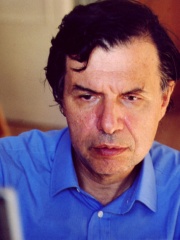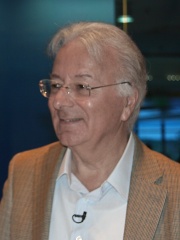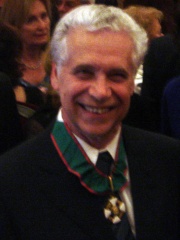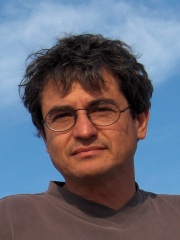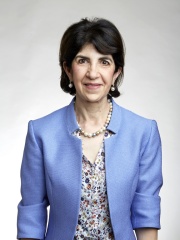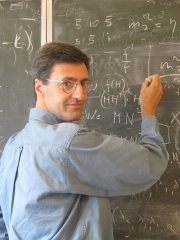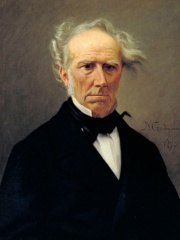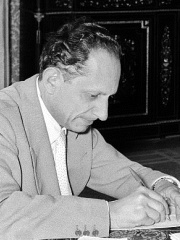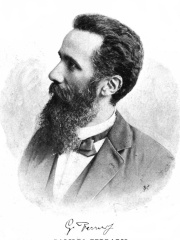
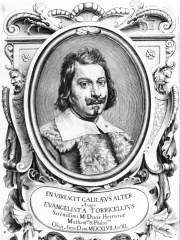
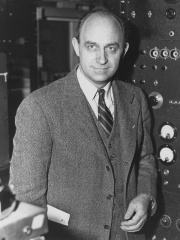
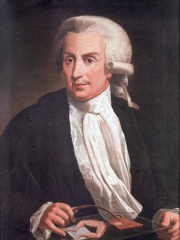
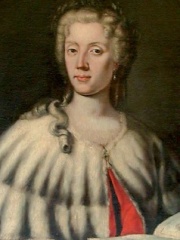
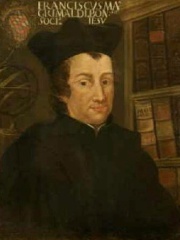
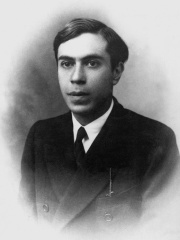
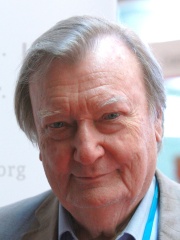
The Most Famous
PHYSICISTS from Italy
This page contains a list of the greatest Italian Physicists. The pantheon dataset contains 851 Physicists, 38 of which were born in Italy. This makes Italy the birth place of the 6th most number of Physicists behind France, and Russia.
Top 10
The following people are considered by Pantheon to be the top 10 most legendary Italian Physicists of all time. This list of famous Italian Physicists is sorted by HPI (Historical Popularity Index), a metric that aggregates information on a biography's online popularity. Visit the rankings page to view the entire list of Italian Physicists.

1. Alessandro Volta (1745 - 1827)
With an HPI of 85.34, Alessandro Volta is the most famous Italian Physicist. His biography has been translated into 107 different languages on wikipedia.
Alessandro Giuseppe Antonio Anastasio Volta (UK: , US: ; Italian: [alesˈsandro dʒuˈzɛppe anˈtɔnjo anasˈtaːzjo ˈvɔlta]; 18 February 1745 – 5 March 1827) was an Italian chemist and physicist who was a pioneer of electricity and power, and is credited as the inventor of the electric battery and the discoverer of methane. He invented the voltaic pile in 1799, and reported the results of his experiments in a two-part letter to the president of the Royal Society, which was published in 1800. With this invention, Volta proved that electricity could be generated chemically and debunked the prevalent theory that electricity was generated solely by living beings. Volta's invention sparked a great amount of scientific excitement and led others to conduct similar experiments, which eventually led to the development of the field of electrochemistry. Volta drew admiration from Napoleon Bonaparte for his invention, and was invited to the Institute of France to demonstrate his invention to the members of the institute. Throughout his life, Volta enjoyed a certain amount of closeness with the emperor who conferred upon him numerous honours. Volta held the chair of experimental physics at the University of Pavia for nearly 40 years and was widely idolised by his students. Despite his professional success, Volta was inclined towards domestic life and this was more apparent in his later years when he tended to live secluded from public life and more for the sake of his family. He died in 1827 from a series of illnesses which began in 1823. The SI unit of electric potential is named the volt in his honour.

2. Evangelista Torricelli (1608 - 1647)
With an HPI of 84.27, Evangelista Torricelli is the 2nd most famous Italian Physicist. His biography has been translated into 84 different languages.
Evangelista Torricelli ( TORR-ee-CHEL-ee; Italian: [evandʒeˈlista torriˈtʃɛlli] ; 15 October 1608 – 25 October 1647) was an Italian physicist and mathematician, and a student of Benedetto Castelli. He is best known for his invention of the barometer, but is also known for his advances in optics and work on the method of indivisibles. The torr is named after him.

3. Enrico Fermi (1901 - 1954)
With an HPI of 83.22, Enrico Fermi is the 3rd most famous Italian Physicist. His biography has been translated into 147 different languages.
Enrico Fermi (Italian: [enˈriːko ˈfermi]; 29 September 1901 – 28 November 1954) was an Italian and naturalized American physicist, renowned for being the creator of the world's first artificial nuclear reactor, the Chicago Pile-1, and a member of the Manhattan Project. He has been called the "architect of the nuclear age" and the "architect of the atomic bomb". He was one of very few physicists to excel in both theoretical and experimental physics. Fermi was awarded the 1938 Nobel Prize in Physics for his work on induced radioactivity by neutron bombardment and for the discovery of transuranium elements. With his colleagues, Fermi filed several patents related to the use of nuclear power, all of which were taken over by the US government. He made significant contributions to the development of statistical mechanics, quantum theory, and nuclear and particle physics. Fermi's first major contribution involved the field of statistical mechanics. After Wolfgang Pauli formulated his exclusion principle in 1925, Fermi followed with a paper in which he applied the principle to an ideal gas, employing a statistical formulation now known as Fermi–Dirac statistics. Today, particles that obey the exclusion principle are called "fermions". Pauli later postulated the existence of an uncharged invisible particle emitted along with an electron during beta decay, to satisfy the law of conservation of energy. Fermi took up this idea, developing a model that incorporated the postulated particle, which he named the "neutrino". His theory, later referred to as Fermi's interaction and now called weak interaction, described one of the four fundamental interactions in nature. Through experiments inducing radioactivity with the recently discovered neutron, Fermi discovered that slow neutrons were more easily captured by atomic nuclei than fast ones, and he developed the Fermi age equation to describe this. After bombarding thorium and uranium with slow neutrons, he concluded that he had created new elements. Although he was awarded the Nobel Prize for this discovery, the new elements were later revealed to be nuclear fission products. Fermi left Italy in 1938 to escape new Italian racial laws that affected his Jewish wife, Laura Capon. He immigrated to the United States, where he worked on the Manhattan Project during World War II. Fermi led the team at the University of Chicago that designed and built Chicago Pile-1, which went critical on 2 December 1942, demonstrating the first human-created, self-sustaining nuclear chain reaction. He was on hand when the X-10 Graphite Reactor at Oak Ridge, Tennessee, went critical in 1943, and when the B Reactor at the Hanford Site did so the next year. At Los Alamos, he headed F Division, part of which worked on Edward Teller's thermonuclear "Super" bomb. He was present at the Trinity test on 16 July 1945, the first test of a full nuclear bomb explosion, where he used his Fermi method to estimate the bomb's yield. After the war, he helped establish the Institute for Nuclear Studies in Chicago, and served on the General Advisory Committee, chaired by J. Robert Oppenheimer, which advised the Atomic Energy Commission on nuclear matters. After the detonation of the first Soviet fission bomb in August 1949, he strongly opposed the development of a hydrogen bomb on both moral and technical grounds. He was among the scientists who testified on Oppenheimer's behalf at the 1954 hearing that resulted in the denial of Oppenheimer's security clearance. Fermi did important work in particle physics, especially related to pions and muons, and he speculated that cosmic rays arose when the material was accelerated by magnetic fields in interstellar space. Many awards, concepts, and institutions are named after Fermi, including the Fermi 1 (breeder reactor), the Enrico Fermi Nuclear Generating Station, the Enrico Fermi Award, the Enrico Fermi Institute, the Fermi National Accelerator Laboratory (Fermilab), the Fermi Gamma-ray Space Telescope, the Fermi paradox, and the synthetic element fermium, making him one of 16 scientists who have elements named after them.

4. Luigi Galvani (1737 - 1798)
With an HPI of 80.29, Luigi Galvani is the 4th most famous Italian Physicist. His biography has been translated into 73 different languages.
Luigi Galvani ( gal-VAH-nee, US also gahl-, Italian: [luˈiːdʒi ɡalˈvaːni]; Latin: Aloysius Galvanus; 9 September 1737 – 4 December 1798) was an Italian physician, physicist, biologist and philosopher who studied animal electricity. In 1780, using a frog, he discovered that the muscles of dead frogs' legs twitched when struck by an electrical spark. This was an early study of bioelectricity, following experiments by John Walsh and Hugh Williamson.
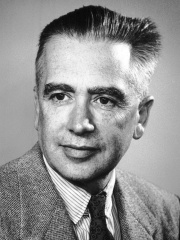
5. Emilio Segrè (1905 - 1989)
With an HPI of 74.45, Emilio Segrè is the 5th most famous Italian Physicist. His biography has been translated into 74 different languages.
Emilio Gino Segrè ( sə-GRAY; Italian: [eˈmiːljo ˈdʒiːno seˈgrɛ]; 1 February 1905 – 22 April 1989) was an Italian-American nuclear physicist and radiochemist who discovered the elements technetium and astatine, and the antiproton, a subatomic antiparticle, for which he was awarded the Nobel Prize in Physics in 1959, along with Owen Chamberlain. Born in Tivoli, near Rome, Segrè studied engineering at the University of Rome La Sapienza before taking up physics in 1927. Segrè was appointed assistant professor of physics at the University of Rome in 1932 and worked there until 1936, becoming one of the Via Panisperna boys. From 1936 to 1938 he was director of the Physics Laboratory at the University of Palermo. After a visit to Ernest O. Lawrence's Berkeley Radiation Laboratory, he was sent a molybdenum strip from the laboratory's cyclotron accelerator in 1937, which was emitting anomalous forms of radioactivity. Using careful chemical and theoretical analysis, Segrè was able to prove that some of the radiation was being produced by a previously unknown element, named technetium, the first artificially synthesized chemical element that does not occur in nature. In 1938 and while Segrè was visiting the Berkeley Radiation laboratory, Benito Mussolini's fascist government passed antisemitic laws barring Jews from university positions. As a Jew, Segrè was rendered an indefinite émigré. At the Berkeley Radiation Lab, Lawrence offered him an underpaid job as a research assistant. There, Segrè helped discover the element astatine and the isotope plutonium-239, which was later used to make the Fat Man nuclear bomb dropped on Nagasaki. From 1943 to 1946 he worked at the Los Alamos National Laboratory as a group leader for the Manhattan Project. He found in April 1944 that Thin Man, the proposed plutonium gun-type nuclear weapon, would not work due to the presence of plutonium-240 impurities. In 1944, he became a naturalized citizen of the United States. On his return to Berkeley in 1946, he became a professor of physics and of history of science, serving until 1972. Segrè and Owen Chamberlain co-headed a research group at the Lawrence Radiation Laboratory that discovered the antiproton, for which the two shared the 1959 Nobel Prize in Physics. Segrè was an active photographer who took many pictures documenting events and people in the history of modern science, which were donated to the American Institute of Physics after his death. The American Institute of Physics named its photographic archive of physics history in his honor.

6. Laura Bassi (1711 - 1778)
With an HPI of 73.68, Laura Bassi is the 6th most famous Italian Physicist. Her biography has been translated into 51 different languages.
Laura Maria Caterina Bassi Veratti (29 October 1711 – 20 February 1778) was an Italian physicist and academic. Recognized and depicted as "Minerva" (goddess of wisdom), she was the first woman to have a doctorate in science, and the second woman in the world to earn the Doctor of Philosophy degree. Working at the University of Bologna, she was the first salaried female teacher in a university. At one time the highest paid employee of the university, by the end of her life Bassi held two other professorships. She was also the first female member of any scientific establishment, when she was elected to the Academy of Sciences of the Institute of Bologna in 1732 at 21. Bassi did not receive formal education; instead, she was privately tutored from the age of five until she was twenty. By then, she was well-versed in major disciplines, including sciences and mathematics. Noticing her ability, Prospero Lambertini, the Archbishop of Bologna (later Pope Benedict XIV), became her patron. With Lambertini's arrangement, she publicly defended forty-nine theses before professors of the University of Bologna on 17 April 1732, for which she was awarded a doctoral degree on 12 May. A month later, she was appointed by the university as its first female teacher, albeit with the restriction that she was not allowed to teach all-male classes. Lambertini, by then the Pope, helped her to receive permissions for private classes and experiments, which were granted by the university in 1740. Bassi became the most important populariser of Newtonian mechanics in Italy. She was inducted by the Pope to the Benedettini (similar to modern Pontifical Academy of Sciences) as an additional member in 1745. She took up the Chair of Experimental Physics in 1776, the position she held until her death. She is interred at the Church of Corpus Domini, Bologna.

7. Francesco Maria Grimaldi (1618 - 1663)
With an HPI of 71.42, Francesco Maria Grimaldi is the 7th most famous Italian Physicist. His biography has been translated into 39 different languages.
Francesco Maria Grimaldi (2 April 1618 – 28 December 1663) was an Italian Jesuit priest, mathematician and physicist who taught at the Jesuit college in Bologna. He was born in Bologna to Paride Grimaldi and Anna Cattani.

8. Ettore Majorana (1906 - 1959)
With an HPI of 70.81, Ettore Majorana is the 8th most famous Italian Physicist. His biography has been translated into 38 different languages.
Ettore Majorana ( MY-ə-RAH-nə, Italian: [ˈɛttore majoˈraːna]; 5 August 1906 – disappeared 25 March 1938) was an Italian theoretical physicist who worked on neutrino masses. Majorana was a supporter of Italian fascism and a member of the National Fascist Party. He disappeared under mysterious circumstances after purchasing a ticket to travel by ship from Palermo to Naples. The Majorana equation, Majorana fermions, and Microsoft's device attempting to create topological qubits, Majorana 1, are named after him. In 2006, the Majorana Prize was established in his memory. In 1938, Enrico Fermi was quoted as saying about Majorana: "There are several categories of scientists in the world; those of second or third rank do their best but never get very far. Then there is the first rank, those who make important discoveries, fundamental to scientific progress. But then there are the geniuses, like Galilei and Newton. Majorana was one of these."

9. Carlo Rubbia (b. 1934)
With an HPI of 69.34, Carlo Rubbia is the 9th most famous Italian Physicist. His biography has been translated into 72 different languages.
Carlo Rubbia (born 31 March 1934) is an Italian particle physicist and inventor who shared the Nobel Prize in Physics in 1984 with Simon van der Meer for work leading to the discovery of the W and Z particles at CERN.

10. Giovanni Battista Venturi (1746 - 1822)
With an HPI of 66.46, Giovanni Battista Venturi is the 10th most famous Italian Physicist. His biography has been translated into 30 different languages.
Giovanni Battista Venturi (11 September 1746 – 10 September 1822) was an Italian physicist, Catholic priest, savant, man of letters, diplomat and historian of science. He was the discoverer of the Venturi effect, which was described in 1797 in his Recherches Experimentales sur le Principe de la Communication Laterale du Mouvement dans les Fluides appliqué a l'Explication de Differens Phenomènes Hydrauliques, translated into English by William Nicholson as "Experimental Inquiries Concerning the Principle of the Lateral Communication of a Motion in Fluids," and published in 1836 in Thomas Tredgold's Tracts on Hydraulics. Because of this discovery, he is the eponym for the Venturi effect, Venturi tube, Venturi flow meter, and the Venturi pump.
People
Pantheon has 38 people classified as Italian physicists born between 1608 and 1967. Of these 38, 8 (21.05%) of them are still alive today. The most famous living Italian physicists include Carlo Rubbia, Giorgio Parisi, and Federico Faggin. The most famous deceased Italian physicists include Alessandro Volta, Evangelista Torricelli, and Enrico Fermi.
Living Italian Physicists
Go to all RankingsCarlo Rubbia
1934 - Present
HPI: 69.34
Giorgio Parisi
1948 - Present
HPI: 65.66
Federico Faggin
1941 - Present
HPI: 64.26
Gabriele Veneziano
1942 - Present
HPI: 61.31
Carlo Rovelli
1956 - Present
HPI: 61.00
Fabiola Gianotti
1960 - Present
HPI: 59.37
Gian Francesco Giudice
1961 - Present
HPI: 47.48
Philip Kim
1967 - Present
HPI: 38.70
Deceased Italian Physicists
Go to all RankingsAlessandro Volta
1745 - 1827
HPI: 85.34
Evangelista Torricelli
1608 - 1647
HPI: 84.27
Enrico Fermi
1901 - 1954
HPI: 83.22
Luigi Galvani
1737 - 1798
HPI: 80.29
Emilio Segrè
1905 - 1989
HPI: 74.45
Laura Bassi
1711 - 1778
HPI: 73.68
Francesco Maria Grimaldi
1618 - 1663
HPI: 71.42
Ettore Majorana
1906 - 1959
HPI: 70.81
Giovanni Battista Venturi
1746 - 1822
HPI: 66.46
Giovanni Battista Amici
1786 - 1863
HPI: 66.10
Bruno Pontecorvo
1913 - 1993
HPI: 65.83
Galileo Ferraris
1847 - 1897
HPI: 64.40
Overlapping Lives
Which Physicists were alive at the same time? This visualization shows the lifespans of the 25 most globally memorable Physicists since 1700.

